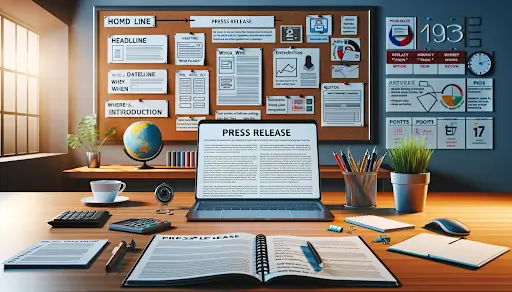How to Write a Press Release? - Maximum Exposure
When businesses and organizations want to spread the word about a specific achievement, new product, or event, they do it with the help of a Press Release. It’s a way to effectively and easily share your narrative with the world.
A press release is similar to writing a letter in which you talk about your initiatives and why they are important to media like newspapers, magazines, or internet platforms. So, let’s discuss the details of how to write a press release that clearly conveys your message and captures the attention of readers.

What is a Press Release?
A press release is a concise written statement that is sent to the media with the purpose of announcing a business achievement, occasion, or product. The announcement may be a promotion, an informational piece, or an update. It serves as an official statement from the organization and is written in an attention-grabbing, journalistic style for readers and reporters.
1 in 4 companies publish over 10 press releases annually. In general, a press release provides answers to the When, Where, What, Why, Who, and How of news. All this essential information is included to help readers quickly grasp the story. It is written to make it easier for reporters to understand and write a story by outlining important details. Using the best Press Release Distribution service ensures that your press release is crafted perfectly and reaches the right audience, enhancing your chances of media coverage.

Format of a Press Release
A press release format usually follows a defined framework in order to guarantee communication effectiveness and clarity. You can get help with the press release format from any of the best press release distribution service companies. This is a breakdown of the typical format:
Header
- You should add your company’s name, address, phone number, email address, and website in your contact information.
- Date of Release: The day on which you want the press release to go live.
- Headline: A brief and compelling headline to convey the main points of the press release.
Dateline
It includes the release date after the city and state (or city and nation) where the press release was released.
Lead paragraph
- Gives a brief yet engaging overview of the announcement or news.
- Provides concise, interesting answers to the who, what, when, where, why, and how questions.
Body Paragraph
- Expands the details given in the introduction.
- To strengthen the story, you can add facts, figures, anecdotes, or supporting information.
Boilerplate
- It is also called the End Notion.
- Provides a brief overview of the company or group that released the press release.
- It includes a mission statement, background information, and any relevant data on the accomplishments and history of the organization.
How to Write a Press Release?
You may get guidance from a number of the best press release distribution service providers in writing the perfect press release. Below are a few steps that you can follow in order to write a good press release.
Summarize Your Story in the Lead
A press release’s lead, or first paragraph, should highlight the key points of the story itself. It should provide journalists with an understanding of the news perspective by answering the who, what, when, where, why, and how questions in the announcement. Many of the best press release distribution service providers can assist you in writing a compelling lead. Incorporating a Press Release in Marketing strategies ensures that your message aligns with your promotional goals, helping you reach your target audience effectively while gaining valuable media coverage.
Write like a journalist
Use a journalistic tone and approach while writing a press release. You should never use jargon or highly promotional language; instead, you have to speak clearly and concisely. To guarantee professionalism and trustworthiness, you should provide the data honestly and with a focus on the facts. You can get help in writing an excellent press release from a number of the best press release distribution service providers.
Be Concise
You should write a press release that is both brief and clear. Try to keep your writing to a page long, or between 300–400 words. Don’t include unnecessary information or filler material. Just add the most important information that should be included. Press releases are more likely to be read and taken into consideration for coverage when they are brief and targeted. Journalists are busy professionals, so show them that you appreciate their time.

Organize your writing
Make sure your press release is logically and clearly organized. A catchy headline should come first, followed by a dateline with the time and place of release. Next, include a boilerplate section about the company or group publishing the release, the lead paragraph, and body paragraphs with supporting facts. It’s also important to consider the Press Release Cost when planning your release, as it can vary depending on the distribution service and scope. Finally, end with your contact details so the media can reach you if they need further information.
Provide Exceptional Value
Make sure your press release provides journalists and their readers with something worthwhile. Make sure your article is newsworthy and appropriate, regardless of whether it contains breaking news, a big announcement, or helpful data. In order to make the news relevant to the intended audience, highlight its advantages or impacts.
Answer all Possible Questions
When you are writing your press release, consider the questions that readers and journalists could have regarding your announcement and be prepared to answer them. You should provide thorough details on the who, what, where, when, why, and how of the narrative. You can also add quotes from influential parties or experts in the field to your release to give it additional weight and credibility.
Final check
To guarantee accuracy and professionalism, carefully review and fact-check your press release before distributing it. Check for any typos, grammatical mistakes, or inconsistent sentences that can take away the authenticity of your writing. You should verify all names, dates, and contact details a second time to ensure accuracy. There are many best press release distribution service providers that can help you review your press release.
Discuss the Outcomes
Before releasing your press release, you should make sure it is accurate and professionally fact-checked. You can double-check your work for any errors in grammar, spelling, or sentence structure that could detract from its genuineness. To guarantee accuracy, double-check all names, dates, and contact information.
Conclusion
A press release is a valuable tool if you want to communicate effectively with the media and the audience. You can write ideal press releases that grab attention, attract media coverage, and advance the targets of your company. You can do this by understanding the function of the release, using journalistic writing approaches, and following best practices for content and distribution.
It’s important to keep your press releases concise, educational, and relevant. Additionally, you should constantly try to provide your audience with high-quality content. You can also hire Reptick to help you with the maintenance of your organization’s image. Contact Reptick today because it is the best online reputation management agency in the market.


